There are several different kinds of layers in the Layered Series, but here I will illustrate the three principal types: modally graded layers, microrhythmic layers, and macrorhythmic layers. Modally graded layers are characteristic of layered intrusions worldwide. They are well represented in the Skaergaard intrusion and grace the pages of many Petrology textbooks. They are generally thought to have been deposited by crystal-rich density currents (of one sort or another) onto the floor (and roof and walls) of the magma chamber.
Modally graded layering
This is the most striking and widespread kind of layering in the Skaergaard pluton. It involves beds that are graded from dark, mafic bases to light, plagioclase-rich tops. The grain size does not vary much within a bed, though the plagioclase-rich tops may be somewhat coarser on average than the bases, because the plagioclase itself tends to be coarser than the mafic minerals. Top and bottom contacts of the beds are usually sharp, typically spanning only one grain thickness. Modally graded layers are local features and can rarely be traced >100 m along strike. The mineralogy of the modally graded beds is identical to the surrounding homogeneous rock. My impression is that the modally graded beds have average mineral proportions very similar to the intervening homogeneous rock, suggesting that the depositional mechanism for the layers was efficient at separating minerals according to density, as well as depositing them. The mechanics of deposition of these layers has long been controversial, but see Irvine et al. (1998).

Close-up of thin graded beds with characteristic dark bottoms and light tops. They are widely spaced with homogeneous rock in between.
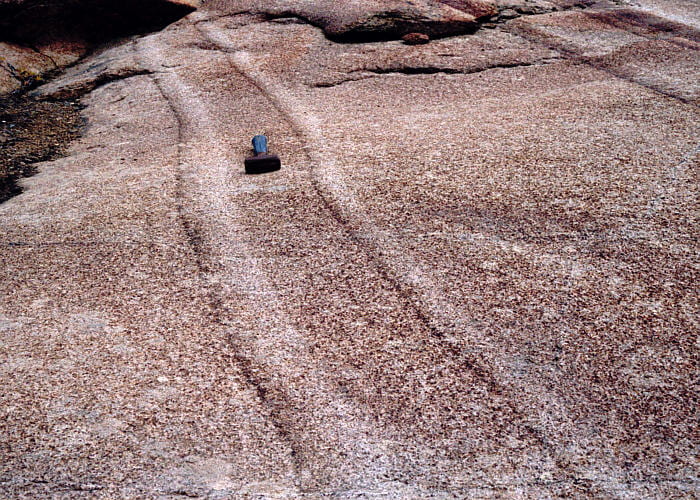
Graded beds near the base of Trough I. Notice that the graded beds appear to have the same average composition as the intervening homogeneous rock.
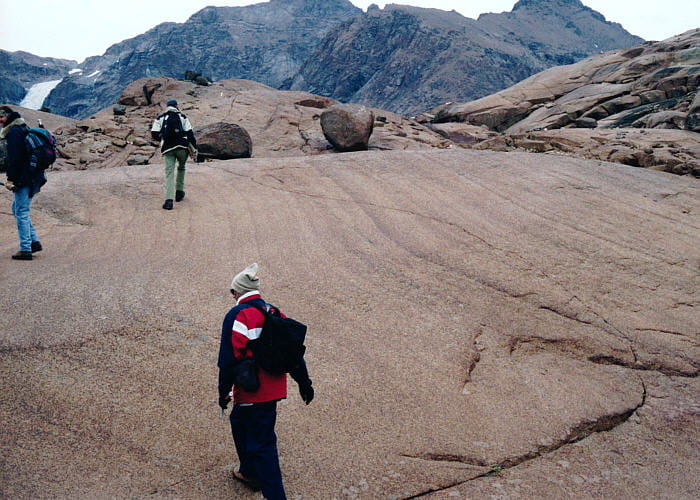
Thick, somewhat faint graded beds in UZa. Beds top to the right. I think this is the side of a ridge and so represents rock transitional between trough and ridge rocks.

Striking graded beds between homogeneous layers, within trough B. Again, my impression is that the graded bed average mineral proportions is the same as the adjacent homogeneous rock.

Splendid graded beds with intervening homogeneous rock. Note the anorthositic replacement along the tops of the two left-most beds.

The upper part of LZc, right below the MZ which is visible as slightly darker brown rocks on the hear horizon. Water in the distance is Uttental Sund, above which is Forbindelses Glacier. Small autholiths are visible, and some truncated layers.
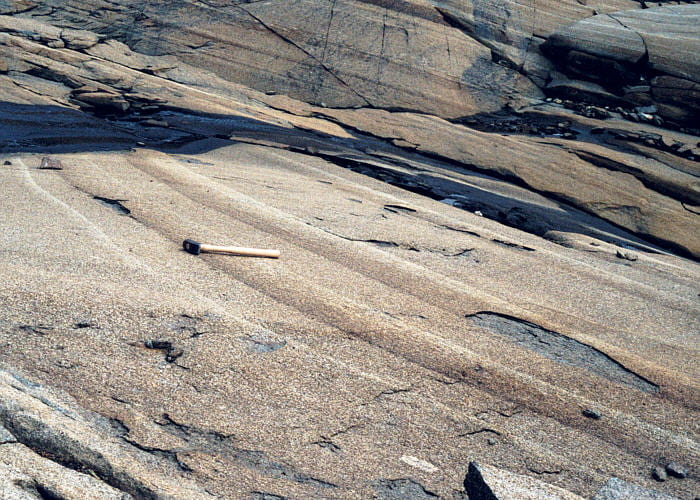
Very nice graded beds in an autolith block-rich area on eastern Kraemer Island.

Thin graded beds in an autolith block-rich area on eastern Kraemer Island.

Graded layers with abundant autoliths strewn within the beds. This implies that the blocks were distributed and deposited by the same currents that deposited the beds.
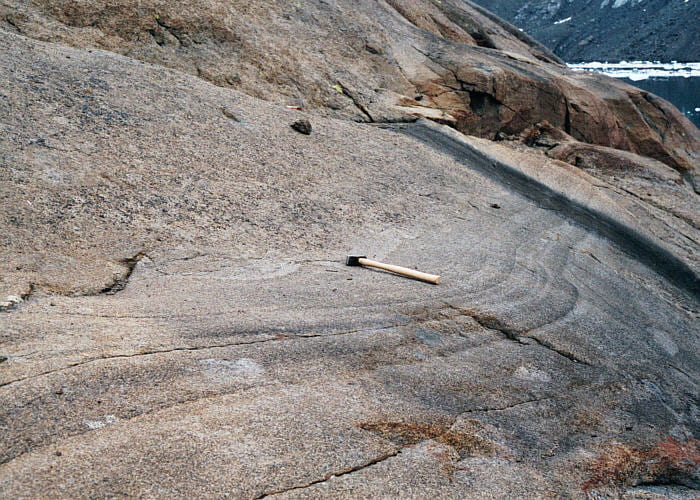
Looking northeast along a giant gabbroic anorthosite block on eastern Kraemer Island, showing the finer-grained layered rock and the coarser grained rock above it. Tops here are to the upper left, so graded layers grade the same way in the roof zone as they do in the Layered Series floor zone.

More graded layering within the same giant gabbroic anorthosite autolith block on eastern Kraemer Island. Note that the layers are normally graded, with mafic bottoms and felsic tops. The layering on the roof therefore grades the same direction as layering on the floor. Rock is cut by a thin basaltic dike.
Microrhythmic layering
This type of layering is rather rare. As I recall it is found only in the lower parts of the fantastic trough structures, and along the flanks of and just above many foundered blocks. Vaguely similar layering was seen in parts of the cross bedded belt on the Uttental Plateau. Microrhythmic layering is defined by mineral modes that vary bidirectionally, differing from the unidirectional modally graded layers.

Microrhythmic layering at the base of Trough F, just above the thin graded beds seen in the first photo on this page. Microrhythmic layering differs from the graded bedding in being generally more regular in layer spacing and thickness, generally without homogeneous intervening rock, generally being associated with the bases of troughs or around autolith blocks, and not having sharp boundaries between dark or light layers.

Close-up view of the microrhythmic layering in the photo above. Magnetite and plagioclase are easy to discern, and the olivine and pyroxenes are both rusty patches.
Macrorhythmic layering
This thick layering style involves bidirectional, generally diffuse gradations between alternating light and dark layers. The scale of layering is generally 0.5 to 3 m, but can be larger. Individual macrorhythmic layers may contain fine structure that include modally graded layers, generally rather subtle. Macrorhythmic layers are abundant in the upper part of the MZ. The most striking of the macrorhythmic layers are the so-called “Triple Group”, a set of three plagioclase-rich light-colored layers in the upper MZ, having intervening more mafic rock. The Triple Group is the principal host for PGE and gold mineralization in the Skaergaard. The macrorhythmic layering is so striking and so well confined to the upper part of the MZ that it suggests a major change in the circulation pattern or depositional mechanisms in the pluton.
View from a landing area at the northern side of the toe of Forbindelses Glacier, on Uttental Sund. View is to the northeast, with the western end of Pukugagryggen on the right, Bjørneskinds Glacier, and Wagers Top in the distance. The Triple Group can be seen on both mountains, as can several large autolith blocks including, below Wagers Top, the largest known in the Skaergaard having a minimum length of 400 m. For better photos see Irvine et al., 2001B, Plate 8. Click on the arrows to see Green A labels representing large autoliths, red subhorizontal lines delineate the Triple Group layers, and red subvertical lines and red M labels show the section having macrorhythmic layering.

Looking north toward the prominent macrorhythmic layering on the lower west flank of Pukugagryggen. Where we were standing on them, the Triple Group members were rather hard to distinguish; they are easier to see from far away.
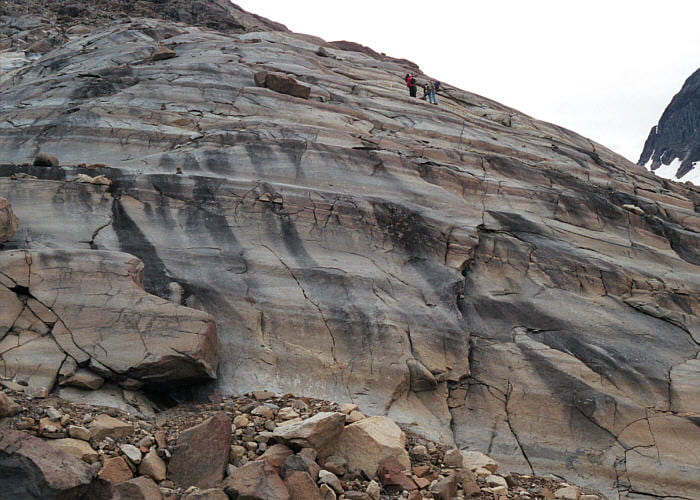
Steep slope of part of the prominent macrorhythmic section. Layering is somewhat diffuse but clear at a distance at a scale of 0.5 to 3 m.
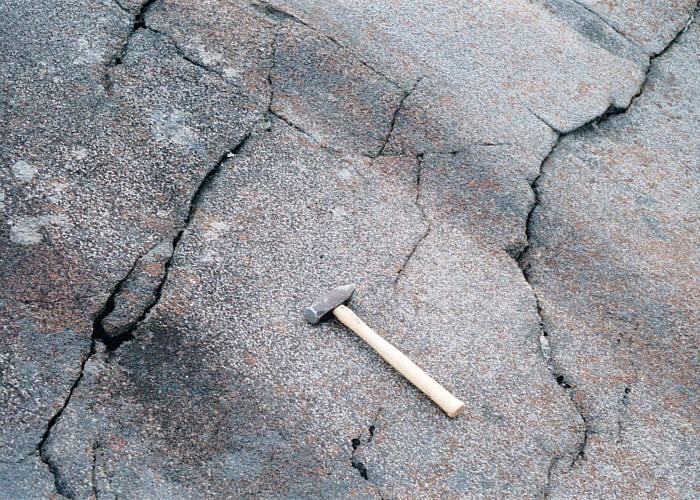
Close-up of the macrorhythmic layering shown in the photo immediately above. Note the diffuse variations in modal composition, and the lack of unidirectional grading.
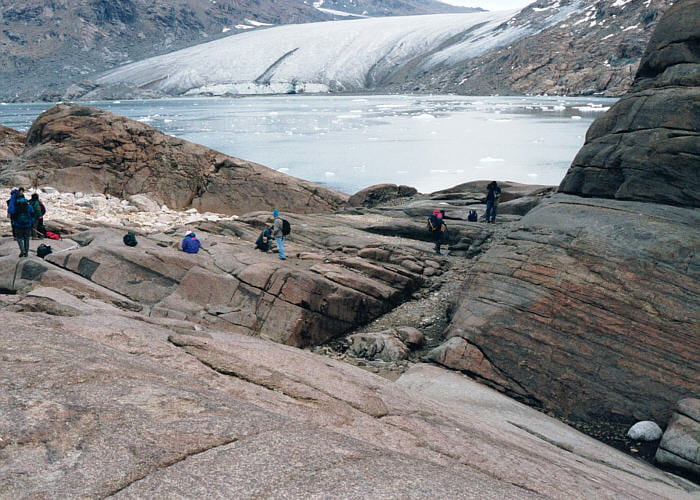
View to the NE across the lowest member of the Triple Group in the near ground, with its overlying more mafic counterpart above and to the right. The contact is about where the blue hat man is standing, just left of center. The Triple Group layers are not homogeneous but contain their own generally subtle layering on different scales. In the distance is Uttental Sund and the toe of Forbindelses Glacier.
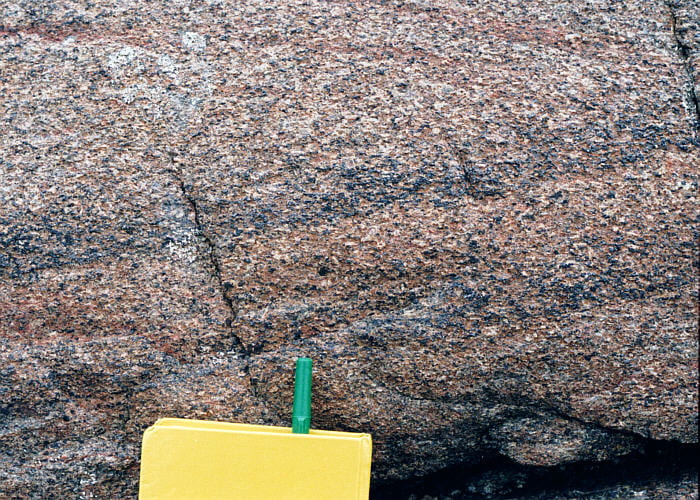
Close-up near the base of the thick mafic layer in the photo above, that overlies the lowest Triple Group member, showing modally graded beds.
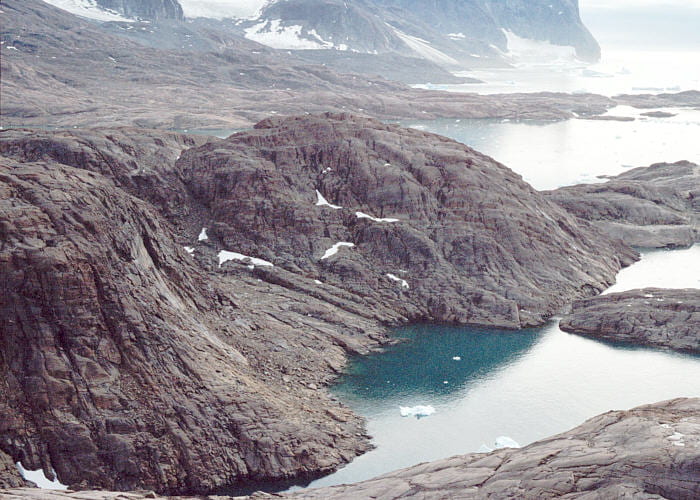
Striking macrorhythmic layering on the southeastern peninsula of Kraemer Island. The body of water nearest is a little embayment just downstream from the lake at 17 m elevation on the topographic map (1975). This view is to the southeast, across Uttental Sund toward the Homestead area and Skaergaard Bay.
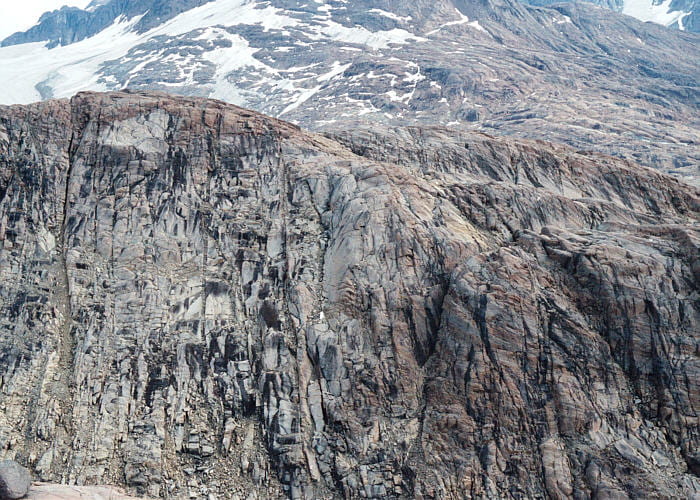
View to the east from Kraemer Island toward Basistoppen. The foreground is the ridge on the southeastern margin of Kramer Island, above the lake at 17 m elevation on the topographic map (1975). The light-colored rock on the left is a giant autolith, with onlapping macrorhythmic layering visible on the right side. It is apparently not the same giant autholth shown on the McBirney (1989) map, which is farther north.


